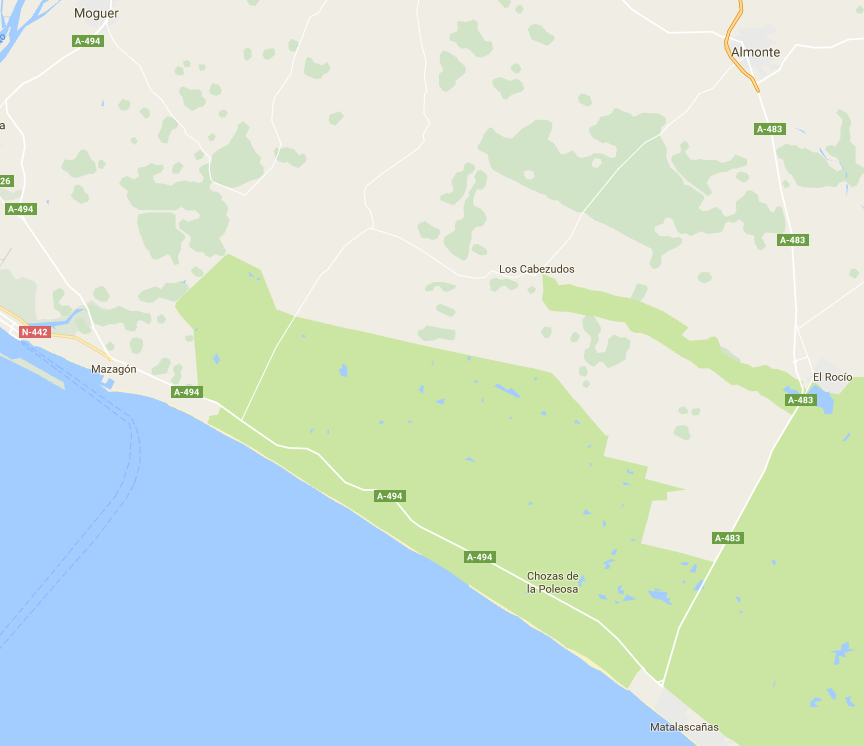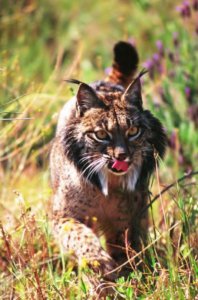
I spent c12 days in the Doñana area in late April/early May, with Ruth Miller, and we were researching a potential book – which we are now writing.
And so it was even more interest and concern than usual that I have watched the news of the massive fire that has consumed large areas of woodland to the west of the National Park (see here, here, here).
If you have ever visited Doñana then you have probably birdwatched at El Rocio and may well have driven south to (or at least towards) Matalascañas on the coast and perhaps called in at the visitor centres to the west of the road, south of El Rocio, at Acebron and Acebuche.
The area affected is to the west of the El Rocio-Matalascañas road and north of the coast. The fire started in the area between Moguer and Mazagon and headed west towards (but not I believe reaching) the tiny place of Los Cabezudos (we went there but I bet not many readers of this blog have!).
Here’s a map of the fire-affected area…

Almonte, El Rocio and Matalascañas are the red areas to the right (east) of the map. Los Cabezudos is more or less in the centre. The red line indicates the area of massive fire and the arrows show which way it was heading. Ruth and I drove through this area one evening after visiting the coast by the Parador at Mazagon. This area is not part of the Doñana National Park but it is part of a slightly lower level of protected area and, essentially, it is a very rich area for wildlife. In particular it is a great area for the very rare and endangered Iberian Lynx – the most threatened large cat in the world with only c350 individuals, c35 of which are in the Doñana area.
Mediterranean vegetation has evolved in a fire-rich environment and given time we can probably expect the area to recover well – but it will take time. Large parts of this area were covered with mature forest and pine plantation.
When such an event happens, it’s a bit difficult to predict how either nature or humankind will react. There is the possibility that habitat recovery could be even better than the habitat which has been lost – that certainly ought to be the aim. On the other hand, in an area under so much human pressure (from water abstraction, agriculture, built development, introduced species, human disturbance, illegal hunting etc etc) it wouldn’t take too much for things to be made worse by crackpot schemes for new roads, industry or dwellings within the affected area. It’s good to see WWF Spain, who have a long and generally very honourable long history of activity in the area, calling on the Spanish authorities to ensure that the whole area is protected for its wildlife into the future.

The future of the Iberian Lynx does not wholly depend on Doñana, in fact I think other areas probably ought to be higher priorities, but we can’t be too sanguine about any part of such a small world population. And the area affected by fire could, as I say above, potentially be restored to an even better area for Lynx with thought, care and time, but there has been another impact.
In the evacuation, the Lynx reintroduction breeding centre, near the Acebuche visitor centre, had to be evacuated too. Staff there had some agonising decisions to make. They could only take some of their breeding stock with them (and just think about it – you can’t ask half a dozen Lynx to get in your car and put their seatbelts on) and so 14 Iberian Lynx (including five kittens) were relocated and another 13 (presumably all adults or near-adults – but I don’t know that) were simply released to take their chances. One of the translocated Lynxes died of stress during the relocation. I expect they had a contingency plan for such an event but you certainly wouldn’t want to be thinking on your feet with winds of 90kph bringing an inferno in your direction.
It seems that the fire is under control now and things have been less disastrous than might have been the case. I haven’t seen any reports of human deaths.
But the worrying thing is that there are rumours (but there always are rumours) that the fire might have been started deliberately. Arsonists don’t always need a motive apart from doing it for the hell of it, but other motives might include wanting to facilitate economic development in the area through a literal scorched earth policy.
Doñana is wonderful – but it is still highly threatened. And this fire is yet another assault on its ecological integrity.
Best wishes to all friends in the area and all wildlife in this amazing area too.
[email-subscribers namefield=”NO” desc=”Get each blog update emailed to you when it appears” group=”Public”]
[registration_form]
efeverde.com are now reporting that 11 of the 13 released lynxes have been relocated. SEO’s initial assessment is that key areas are affected including important stands of maritime juniper and areas for chameleon and Iberian lynx. At least 10,000 ha. affected, but, according to SEO, an impeccable response from the forest fire service, Andalucian environment department and military emergency response unit.
Laurence – many thanks.
I was sad to see a dead chameleon on Twitter – yes, I know it’s just one – because I’ve only ever seen one, and that was in this area!
Sad news indeed. Been there a couple of times, the first time with guides who kept raising our eyebrows with tales of lynx in the quiet places they took us. Of course we didn’t see one, most don’t – but they did show us pretty much everything else. I got the impression ten years ago, that the whole area was just about holding on to its remarkable wildlife. It would be devastating to see it go.
How very sad.
Happy memories of Red Knobbed (crested) Coots and the ‘cowboy’ town of El Rocio.
Let’s hope that nature is allowed to take its course before man does.
Leaving aside concerns regarding Iberian Lynx, this isn’t necessarily the disaster it first seems as the area will recover if left to do so. I guess burned areas could even encourage the rabbit population in the near future (the main food for Spanish Imperial Eagle & Lynx). But there’s the rub, my Spanish friends tell me that the law was recently relaxed to make it easier to build on areas that have been burned. It sounds like an arsonist’s charter to me and most of those I’ve heard from are convinced that sinister forces are at work …
When I was a kid my interest in wildlife was cemented by my wonderful grand parents subscribing to ‘The World of Wildlife’ magazine for me, building into a set of encyclopedias, it was produced by Orbis. Absolute classic and I can’t possibly be the only one of my generation that read it and till this day cherish. There were two places mentioned in the whole set of 11 books that really left an impression on my mind and the first was Coto Donana. So I’ve never been there (although I’ve been in southern Spain) but I feel I know it after spending so much of my child hood reading about it and after hearing for years how it’s been abused (Chris P did a prog on it years ago) and threatened by the horrendous development you get in Spain this is pretty tragic news. The idea the fire was started deliberately to aid development is all too plausible.
This happened to a protected site for tortoises in Greece that the locals wanted to build a hotel on (I don’t believe they got their way after all), and is suspected to have been the cause of major fires in a protected area of southern Mexico. Then there was the extensive loss of araucaria trees in the area where the original Walking with Dinosaurs series was filmed when out of spite local farmers set fire to them because they were not allowed to log the trees. These places are so, so precious and they are constantly under siege by chancers. Even our local wood came under threat from one. The other place that World of Wildlife entranced me with was Bialowieza…..bummer. Conservation orgs need to beef up.
Sad news, Mark. Let’s hope a phoenix rises from the ashes.
very messed up but one can’t help but draw from this timeline;
1- new law allowing construction in burned land if it is for ‘public benefit’ (2014)
2- one of the main companies proposes a project to do some gas storage somewhere in Doñana (2015)
3- the government declares te above mentioned project of ‘public benefit’ (2016)
4- Doñana is burned to ashes (2017)
Now that is messed up!
I suggest readers of this blog sign this petition:
https://www.change.org/p/susana-d%C3%ADaz-reforestar-doñana-no-permitir-el-almacenamiento-de-gas-natural?recruiter=29929777&utm_source=share_petition&utm_medium=facebook&utm_campaign=share_petition&utm_term=autopublish&utm_content=nafta_share_post_title_es-es_1%3Acontrol
Ecologists from Ecologistas en Acción and Greenpeace have commented on “el bulo” – the rumoured chain of events that Simon references above, which is circulating widely on Spanish social networks. http://www.publico.es/sociedad/incendio-donana-ecologistas-desmienten-bulo-donana-no-quemado-recalificar-terrenos.html
They say that there’s no reason to link the fire in Doñana with real estate speculation. Also that the new law allowing construction on burned land (la Ley del Montes), which Simon mentions, does not apply in the Parque Natural & Parque Nacional of Doñana, which have their own regulations and are covered by a different law (la Ley de Patrimonio Natural).
However, Ecologistas en Accion have released this statement (http://www.ecologistasenaccion.org/article34566.html#.WVJxqK6UnkI.twitter) which strongly implies that private interests are being the fire, and the burning of Doñana. They are calling for stronger regulation and total restoration of the affected area, with ‘not a single square metre of forested area in Doñana lost to other uses’.
Meanwhile, Greenpeace has written this article calling on people to avoid simplificiations in the causes of wildfires: http://www.greenpeace.org/espana/es/Blog/incendios-forestales-hay-que-evitar-las-simpl/blog/59723/?utm_medium=social_network&utm_source=twitter&utm_campaign=bosques&utm_content=incendio&utm_term=do%C3%B1ana. It’s a very measured piece, highlighting the importance of personal, social & institutional responsibility; the need to learn more about wildfires; and the importance of preparing ourselves for what we’ll continue to have to live with – this ‘new generation’ of forest fires which, according to the experts, will become increasingly frequent in future.
Apologies for the epic comment, but this happened to be the subject of my Spanish conversation class this evening, with my Andalusian teacher.
Am quite taken with this phrase from the end of that Greenpeace article “Y dejemos de lado tanto topicazo.” Hard to translate, but I think here it means something like “Let’s not be so opinionated.”
Clare – muchas gracias. Thank you very much indeed.